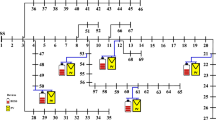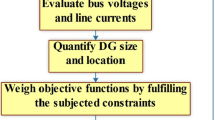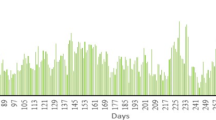Abstract
The aim of this paper is to reduce losses and improve voltage profile of a distribution feeder taking into account probabilistic nature of PV sources and loads, using particle swarm optimization algorithm. The proposed method uses normal distribution and beta distribution for probabilistic modeling of the loads and irradiation respectively. By applying probabilistic load flow, voltage profile and losses for the network are calculated 24 hours a day and four seasons a year. Based on overall results the optimal size of installed PV resources in each buses on the feeder are obtained and compared to the results obtained from a conventional method.
Similar content being viewed by others
References
Jurado, F. and Carpio, J., Enhancing the distribution networks stability using distributed generation, Int. J. Comput. Math. Electr. Electron. Eng., 2005, vol. 24, no. 1, pp. 107–126.
Borkowska, B., Probabilistic load flow, IEEE Trans. Power Apparat. Syst., 1974, vol. PAS-93, no. 3, pp. 752–75.
Allan, R.N., Borkowska, B., and Grigg, C.H., Probabilistic analysis of power flows, Proc. Inst.Electr. Eng. (London), 1974, vol. 121, no. 12, pp. 1551–1556.
Zhang, P. and Lee, S.T., Probabilistic load flow computation using the method of combined cumulants and Gram-Charlier expansion, IEEE Trans. Power Syst., 2004, vol. 19, no. 1, pp. 676–682.
Arienti, V.L. and Allan, R.N., Probabilistic load flow considering dependence between input nodal powers, IEEE Trans. Power Apparat. Syst., 1984, vol. PAS-103, no. 6, pp. 1524–1530.
Barker, P.P. and De Mello, R.W., Determining the impact of distributed generation on power systems: part 1 — radial distribution systems, Proc. IEEE Power Engineering Society Summer Meeting, Seattle, 2000, vol. 3, pp. 1645–1656.
Nara, K., Hayashi, Y., Ikeda, K., and Ashizawa, T., Application of tabu search to optimal placement of distributed generators, Proc. IEEE Power Engineering Society Winter Meeting, Columbus, OH: Institute of Electrical and Electronics Engineers, Jan. 28, 2001, vol. 2, pp. 918–923.
Kyu-Ho Kim, Yu-Jeong Lee, Sang-Bong Rhee, and Sang-Kuen Lee, Dispersed generator placement using fuzzy-GA in distribution systems, Proc. IEEE Power Engineering Soc. Summer Meeting, Chicago, 2002, vol. 3, pp. 1148–1153.
Celli, G., Ghiani, E., Mocci, S., and Pilo, F., A multi-objective evolutionary algorithm for the sizing and siting of distributed generation, IEEE Trans. Power Syst., 2005, vol. 20, no. 2, pp. 750–757.
Harrison, G.P., Piccolo, A., Siano, P., and Wallace, A.R., Exploring the tradeoffs between incentives for distributed generation developers and DNOs, IEEE Trans. Power Syst., 2007, vol. 22, no. 2, pp. 821–828.
Piccolo, A. and Siano, P., Evaluating the impact of network investment deferral on distributed generation expansion, IEEE Trans. Power Syst., 2009, vol. 24, no. 3, pp. 1559–1567.
Smith, J.W. and Brooks, D.L., Voltage impacts of distributed wind generation on rural distribution feeders, Proc. IEEE/PES Transmission and Distribution Conf. and Exposition, Atlanta, 2001, vol. 1, pp. 492–497.
Greatbanks, J.A., Popovic, D.H., Begovic, M., et al., On optimization for security and reliability of power systems with distributed generation, Proc. IEEE Proce Power Tech Conf., Bologna, 2003, vol. 1, pp. 1–8.
Atwa, Y.M., El-Saadany, EF., Salama, M.M.A., and Seethapathy, R., Optimal renewable resources mix for distribution system energy loss minimization, IEEE Trans. Power Syst., 2010, vol. 25, no. 1, pp. 360–370.
Skoplaki, E. and Palyvos, J.A., On the temperature dependence of photovoltaic moduleelectrical performance: a review of efficiency/power correlations, Solar Energy, 2009, vol. 83, no. 5, pp. 614–624.
Kashem, M.A., Ganapathy, V., Jasmon, G.B., and Buhari, M.I., A novel method for loss minimization in distribution networks, Proc. Int. Conf. on Electric Utility Deregulation and Restructuring and Power Technologies, London, 2000, pp. 251–255.
Swagatam D., Ajith, A., Amit, K., Particle swarm optimization and differential evolution algorithms: technical analysis applications and hybridization perspectives, Adv. Comp. Intellig. Industr. Syst. Studies Comput. Intellig., 2008, vol. 116, pp. 1–38.
Sedighizadeh, D. and Masehian, E., Particle swarm optimization methods, taxonomy and applications, Int. J. Comput. Theory Eng., 2009, vol. 1, no. 5, pp. 486–502.
Author information
Authors and Affiliations
Corresponding author
Additional information
The article is published in the original.
About this article
Cite this article
Shojaeian, S., Naeeni, E.S. Probabilistic optimal sizing of PV units in a distribution network. Appl. Sol. Energy 50, 125–132 (2014). https://doi.org/10.3103/S0003701X1403013X
Received:
Published:
Issue Date:
DOI: https://doi.org/10.3103/S0003701X1403013X




